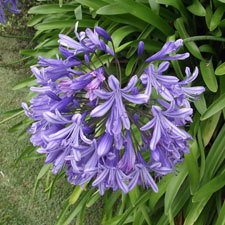 Agapanthus
Agapanthus
Common name: Agapanthus
Botanical name: Agapanthus praecox
Management programme: Advisory
Originates from South Africa. Brought to New Zealand as an ornamental garden plant and naturalised in 1952. Gardeners loved it for its ever-present flowers year round and hardiness.
Why is it a pest?
- Agapanthus are long-lived prolific seeders. They are very tolerant to temperature, rainfall, salt, poor soils and can survive immersion in the sea.
- They form dense stands becoming the dominant species wherever it grows.
- It causes massive biodiversity loss, especially of rare coastal herb, grass and shrub communities.
- They are particularly invasive in coastal environments, outcompeting native coastal plants.
- Agapanthus are very difficult to control. They can survive mowing, grazing, insects, and spraying.
Where is it found?
Agapanthus are commonly found in gardens, roadsides, and banks throughout the Bay of Plenty. They are spread by seed dispersal as well as from dumped vegetation and deliberate planting.
What does it look like?
- Robust, clump forming lily with long (up to 70cm), arching, strap shaped leaves and long, thick, white rhizomes
- Attractive blue or white flowers form umbrella-shaped clusters of small flowers December to February. These are followed by thin, papery, black seeds.
What are the rules?
Advisory
The Bay of Plenty Regional Council does not enforce the control of advisory species. It is landowner/occupier responsibility to manage these pests. Council may provide advice on how to manage or control these species if required.
How do you get rid of it?
Recommended:
- Dig out smaller isolated plants. Ensure that the whole rhizome is removed.
- Slash leaves close to the ground and paint the fresh stump with vigilant gel, glyphosate, or metsulfuron-methyl.
- Spray with triclopyr.
Plants will often resprout from rhizomes and will require follow up treatment until all plants are killed. Do not replant the area until all of the agapanthus have been controlled. If plants are situated on a bank it is best to start control at the top of the bank and work your way down. Remove flower heads early summer to stop seed dispersal.
CAUTION: When using any herbicide or pesticide, PLEASE READ THE LABEL THOROUGHLY to ensure that all instructions and directions for the purchase, use and storage of the product, are followed and adhered to.
Read more on pest control advice, information and regulations.
Images




